Coronavirus (COVID-19) volunteering - third sector perspectives: survey report
Findings from a survey undertaken to gather insights into the experiences of Scottish third sector organisations and other stakeholders involved in supporting volunteering during the pandemic.
4 Effectiveness of the volunteering response and the role of different types of volunteering
We asked respondents about the extent to which they agreed that volunteers were essential to the functioning of their organisation during COVID-19. Infrastructure organisations and volunteer-involving organisations agreed that the volunteer response was crucial to underpinning the COVID-19 response across Scotland.
Infrastructure organisations tended to focus on the effectiveness of the community response that emerged at the beginning of the crisis, while VIOs focused on the role of formal volunteers in helping to maintain the delivery of their programmes, and on the willingness of their staff and volunteers to undertake steps to adapt their work to ensure that formal volunteering could continue where possible. Overall, 82% of VIOs strongly agreed or agreed that volunteers had been essential to the functioning of their organisation during the pandemic (Figure 4.1).
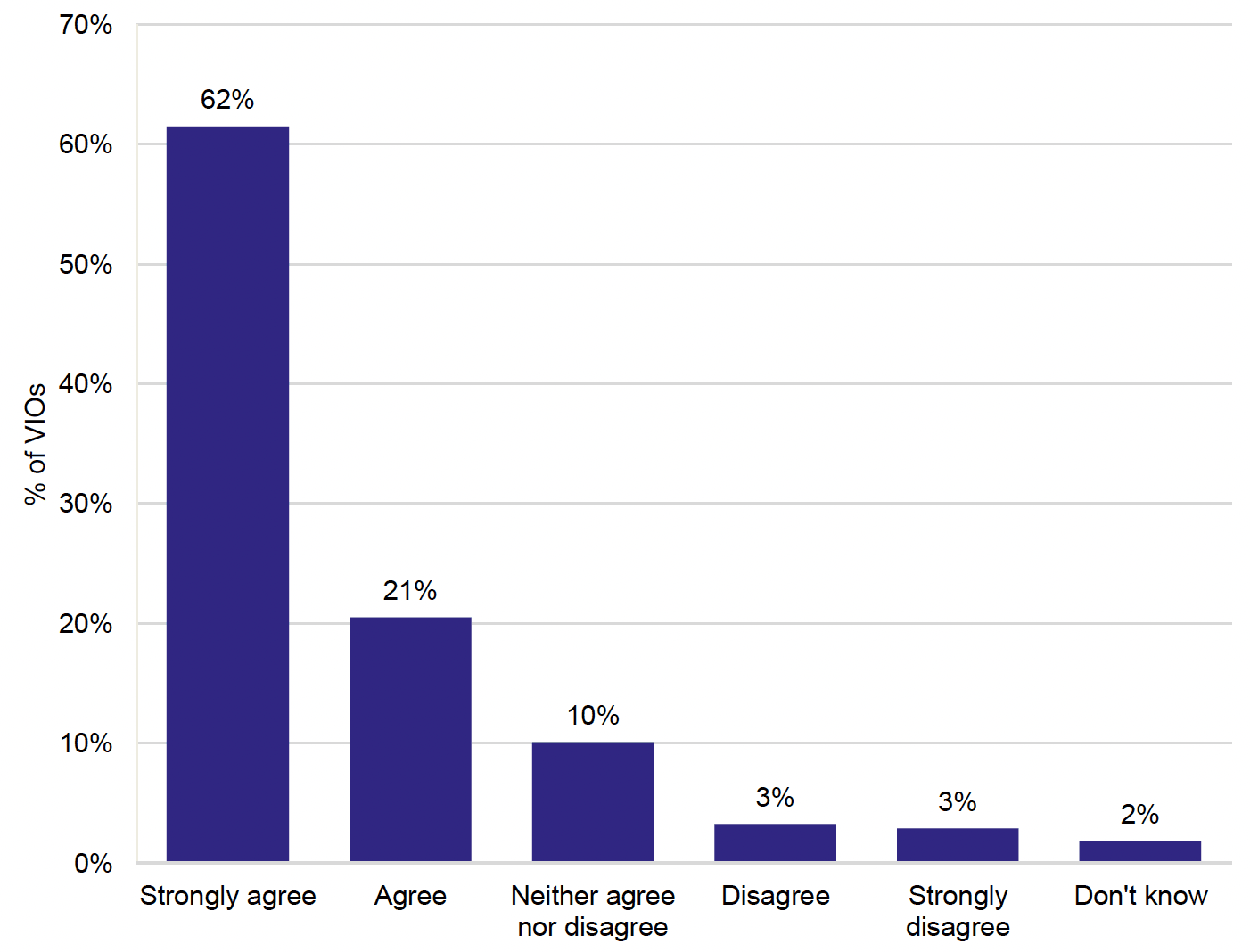
4.1 The role of different types of volunteering in the COVID-19 response
One of the most striking aspects of the COVID-19 pandemic was the huge upswell in community-level support responses that accompanied the first lockdown in particular. This was characterised by:
- The rapid emergence of many new community support groups, often created or maintained using social media channels like Facebook or WhatsApp. Whilst some of these groups were entirely new, others were linked with pre-existing groups or structures. These groups have been called 'mutual aid' groups by some commentators, although this is not necessarily a term that all of these groups would use or recognise. It is not clear how many such groups were created in Scotland, although there have been some attempts to map them.[11]
These groups tended to operate in relatively informal ways, inviting potential volunteers in local areas to sign up to help via digital platforms. Organisation of these groups was often horizontal rather than hierarchical. As requests arose within the community, these would be advertised to the group, with volunteers self-selecting to respond.
The structures and level of formal constitution of these groups varied hugely, including very informal 'pop-up' groups created by concerned groups of individuals, and groups that were set up as part of – or which became linked to – pre-existing community organisations and structures with a certain level of organisational capacity already in place.
- Growth in 'informal' volunteering – people making efforts to check in with and support their neighbours, friends, colleagues and so on. There was some degree of crossover/fluidity between this informal neighbourhood volunteering and the community support/mutual aid groups.
At the same time, pre-existing formal volunteering opportunities in many volunteer-involving organisations had reduced in the face of lockdown, as organisations had to suspend their usual activities and programmes. As such, informal volunteering, mutual aid and other dedicated COVID response efforts were a primary route for 'new' volunteers to start volunteering, or to volunteer in support of the COVID response specifically.
Infrastructure organisations were asked to reflect on these different forms of volunteering, and their relative effectiveness or strengths and weaknesses in terms of their ability to respond to the needs that arose during the pandemic.
4.1.1 Effectiveness of formal and mutual aid volunteering in responding to COVID-19
Figures 4.2a and 4.3a compare the effectiveness of the formal and mutual aid responses across a number of criteria, including speed, safeguarding, coverage of the response in areas of deprivation, and ability to meet people's needs, according to infrastructure organisations.
For all criteria, infrastructure organisations were more likely to rate the formal volunteering response as effective than the mutual aid response, for both the first and the second lockdowns. However, this was in part because infrastructure organisations were much more likely to give 'don't know' responses in relation to the questions about mutual aid organisations, probably because they had not necessarily had direct contact with all of these organisations.
For both types of volunteering, a smaller percentage of respondents rated the responses as effective in the second lockdown compared with the first lockdown. However, this was a result of a much higher level of 'don't know' responses in relation to the second lockdown – not because respondents necessarily thought that the response was less effective. In fact, the percentage of respondents who rated the responses as ineffective (across all criteria) dropped very slightly for the second lockdown.
This increase in 'don't know' responses for the second lockdown was not explained in the comments, although there were some comments to suggest that the overall volunteer response was more routine and 'calmer' during the second lockdown – which perhaps meant that infrastructure organisations were less aware and less able to comment on the detail of that activity.
'Communities appeared to take the second lockdown 'in their stride'; they had the experience of the first period and there was a more organised and calmer approach to the second period of lockdown.'
Figures 4.2b and 4.3b show the same data, this time excluding the 'don't know' responses. When presented in this way, the data show that where respondents felt able to give a rating to the mutual aid and formal volunteering responses they rated them fairly similarly across many of the questions.
For the first lockdown, once 'don't know' responses are excluded, respondents rated the mutual aid response as slightly more effective than the formal volunteering response in terms of its speed, coverage, and ability to meet immediate needs. This is in line with the qualitative comments and other evidence (see Figure 4.4) that the speed of response was extremely rapid from mutual aid organisations – with many forming and becoming active very rapidly at the start of the pandemic.
The main area where respondents clearly rated the mutual aid response less positively than the formal volunteering response was in relation to the ability of mutual aid responses to ensure good standards of care and safeguarding to the people being helped. This was echoed in Figure 4.4 and in comments that suggested that mutual aid organisations did not always have clear safeguarding procedures or training in place to support volunteers from the outset.
Several respondents noted that there was a drop-off in some aspects of COVID-response volunteering during the second lockdown, as more people went back to work, as some people who had received support during the first lockdown had been able to make alternative arrangements for the second; and as formal and statutory providers were better prepared for the second lockdown. Respondents also noted that some mutual aid groups had disbanded by the second lockdown – while others had moved towards becoming constituted as formal organisations or creating formal links with constituted groups. The reduced activity profile of some mutual aid groups during the second lockdown may also have contributed to the very high proportion of 'don't know' responses in relation to mutual aid volunteering during the second lockdown in particular.
'Many of the mutual aid groups started up during the first lockdown do not appear to have started up again during second lockdown: however, some established themselves as constituted organisations in their own right or had established connections and partnerships since first lockdown, volunteering for constituted groups that were better able to work with statutory partners during second lockdown.'
'[Local Authority area] witnessed mutual aid organisations being set up overnight. Initially these groups were very effective but as time passed you could see they ran out of enthusiasm and possible funding.'
'The mutual aid response was stronger during the first lockdown, but still remains a significant response and there is an increased sense of online community with several mutual aid groups supporting traditional organisations or currently looking at formalising and registering as a charity'
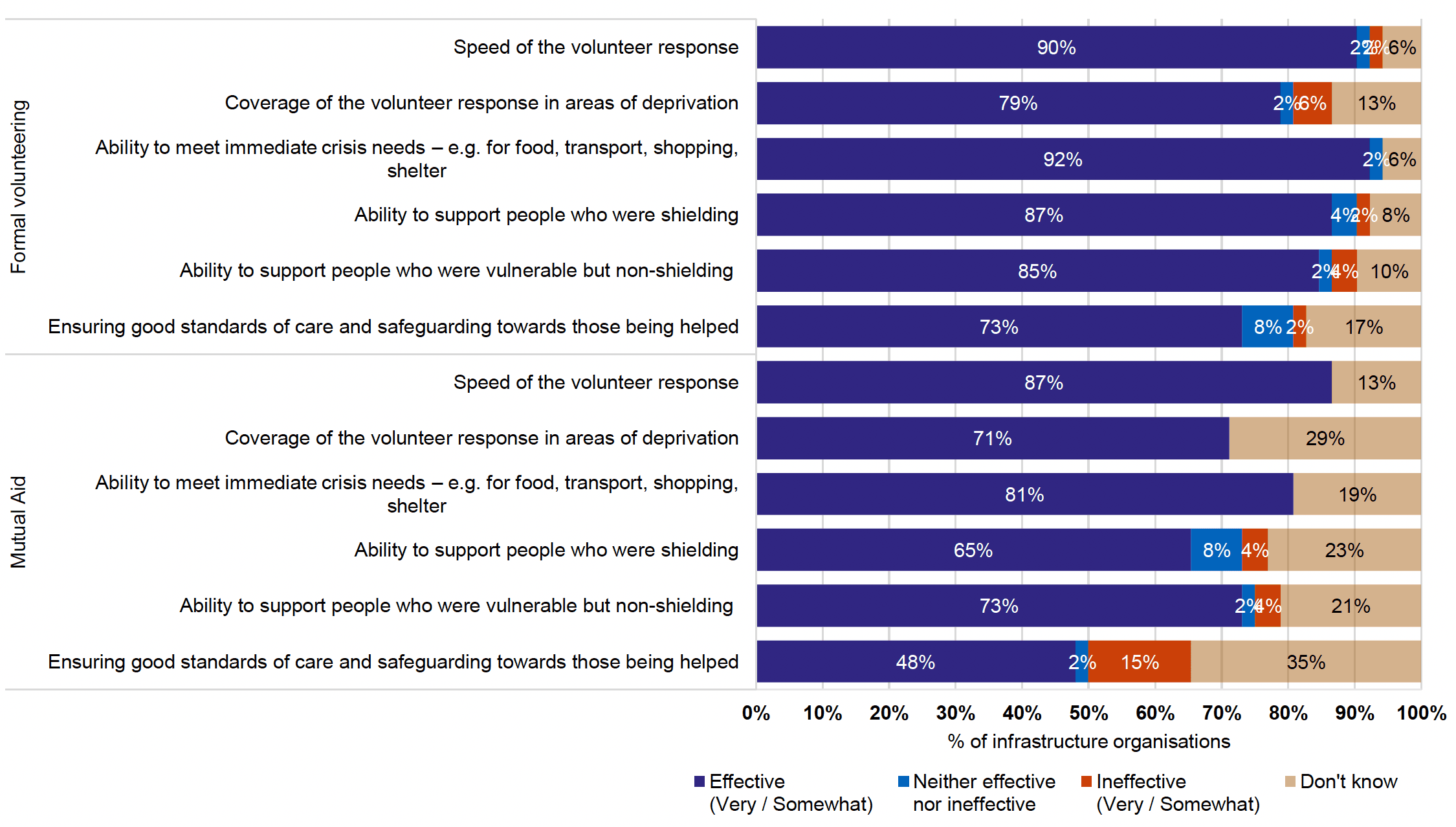
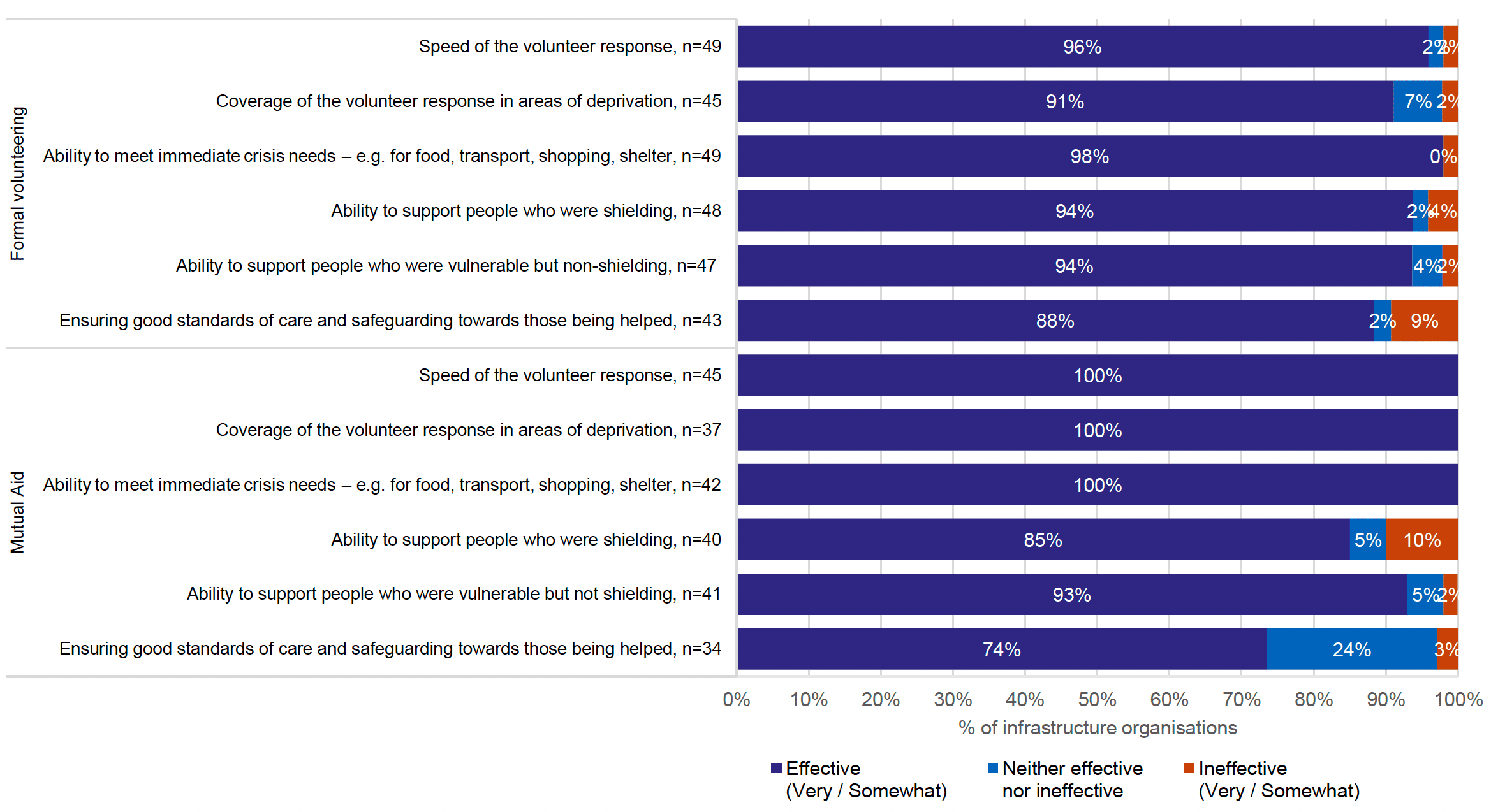 Figure 4.3a: Infrastructure organisation views of the effectiveness of formal and mutual aid volunteering during the second lockdown (Dec 2020-Apr 2021, N=52)
Figure 4.3a: Infrastructure organisation views of the effectiveness of formal and mutual aid volunteering during the second lockdown (Dec 2020-Apr 2021, N=52)
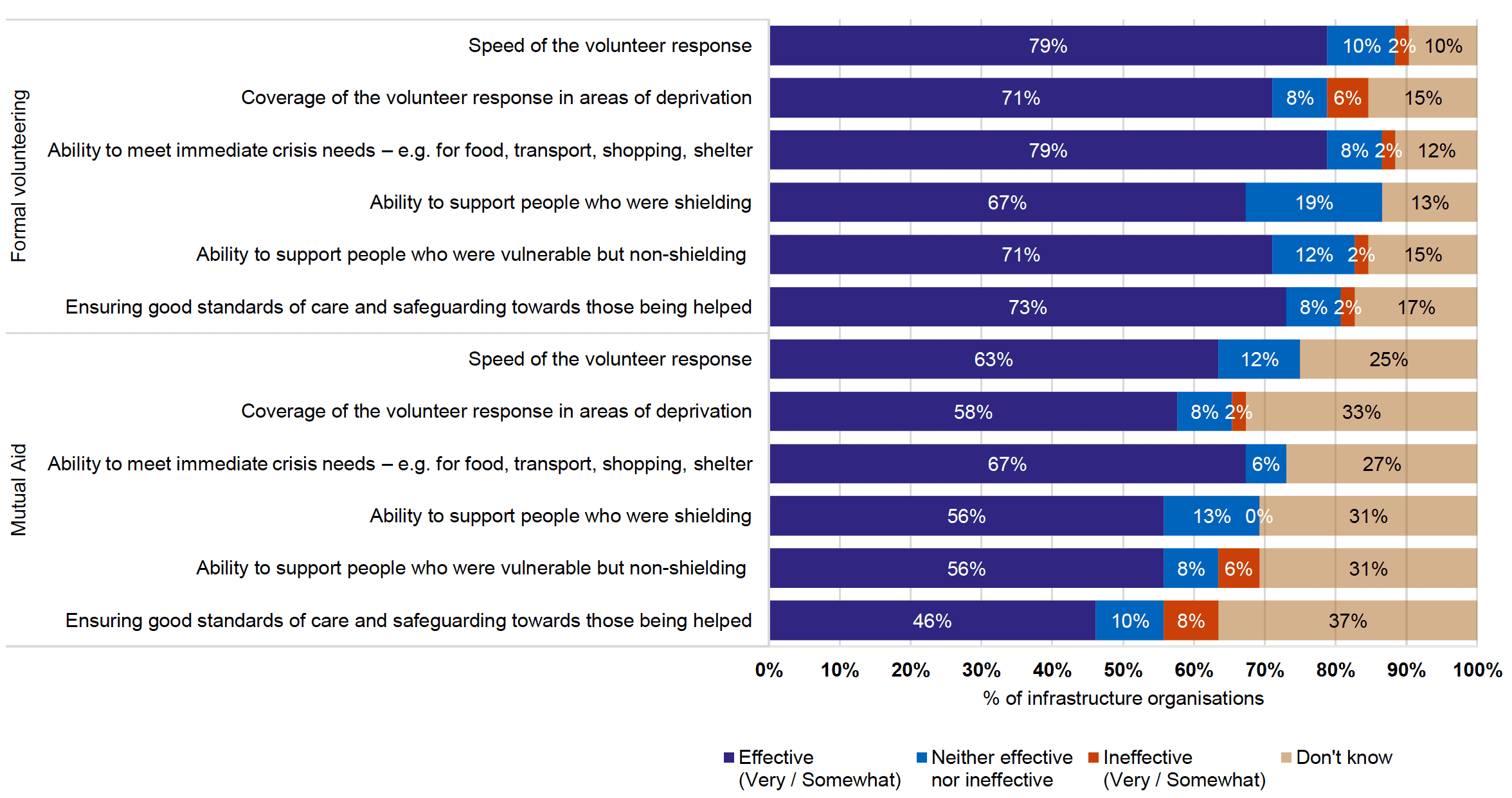
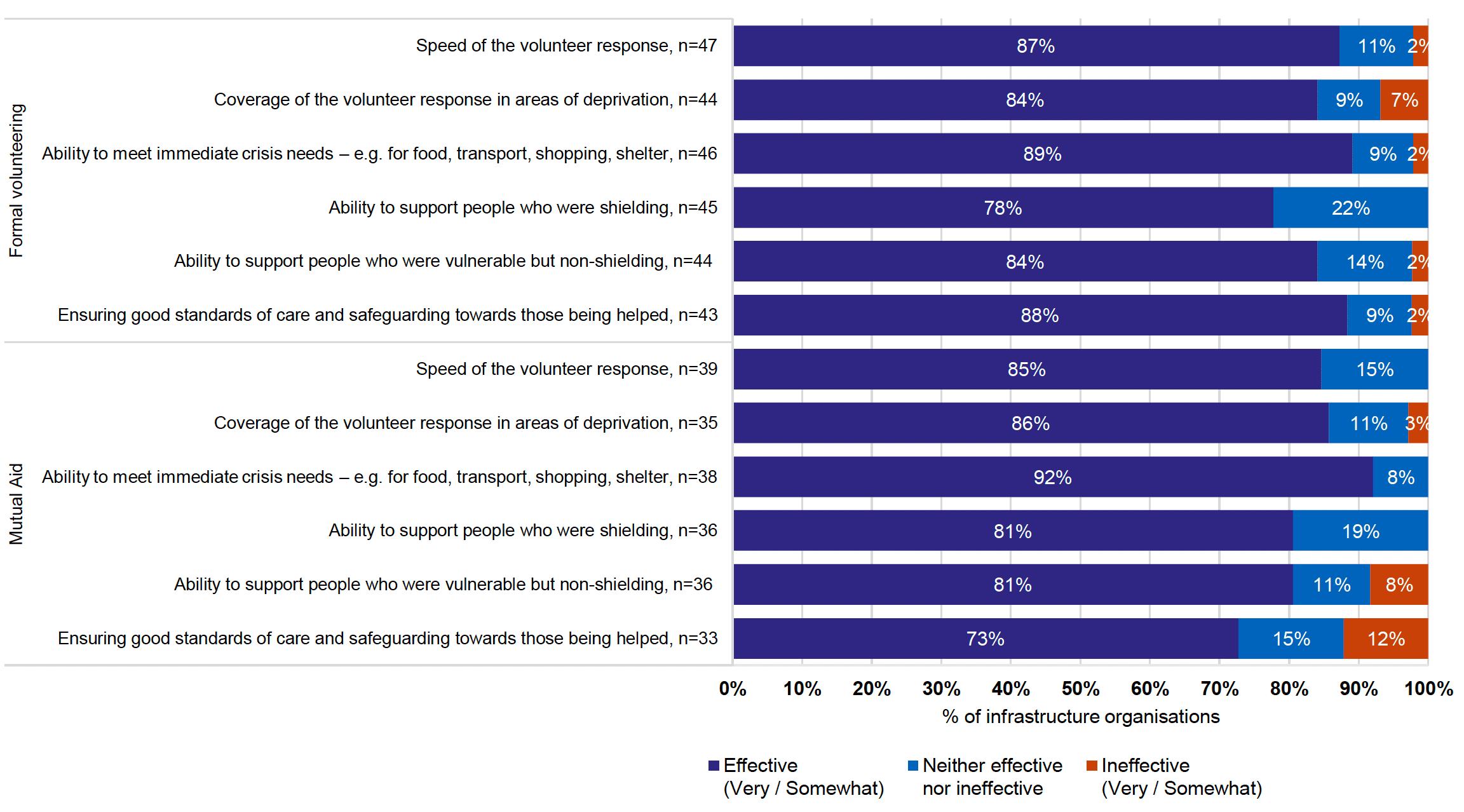
Figure 4.4 gives infrastructure organisation views on a series of questions relating specifically to mutual aid volunteering.
Many respondents stressed that the response was most effective when the different types of formal, informal and mutual aid volunteering worked together – for example, with mutual aid organisations linking with formal support organisations to refer people with needs that they could not themselves respond to. Overall, 85% of infrastructure organisations agreed that mutual aid groups provided an essential complement to the formal volunteering response.
'In the first days of the first lockdown we became aware of a number of new groups emerging; some had fairly good coordination and a planned approach [while] others were more random in their approach with more of a focus on the practical activities rather than on organising themselves. All in all there was a very good response and people did get the help they needed. We became aware of existing groups adapting what they were doing to include COVID-related support and the total number of groups involved was more than 200.'
Infrastructure organisations also felt that the mutual aid groups had been able to attract new or different volunteers to those who were already engaged as formal volunteers. Mutual aid volunteers tended to be younger, and not necessarily to have volunteered before. This may reflect the fact that people 70 and over were asked to remain at home and take great care during the pandemic; meanwhile a significant group of working-age people had time to volunteer, due to furlough. The focus on digital platforms for organising these groups, and their relative informality, may also have made them more accessible or appealing to younger ages.
'Local Facebook page set up and run by volunteers. Very effective in sharing information and seeking out volunteers and support during the pandemic. Also shared local 'live-streamed' music etc for entertainment.'
Infrastructure organisations expressed some concerns in relation to the mutual aid response. Sixty percent of the respondents agreed that safeguarding and confidentiality concerns were not always well addressed, particularly in instances where mutual aid groups had been newly formed. The informality of the formation of the groups meant that in some cases at the outset they did not have clear governance arrangements; established policies and practices in relation to safeguarding; and training/guidance in place for volunteers. This was of concern given the vulnerability of some of the people who were being supported by these groups.
'I think they were fantastic at getting people the basics quickly and efficiently although safeguarding for those we spoke to often didn't appear as a focus or sometimes something that had been considered. Although we are not aware of any instances of harm that occurred.'
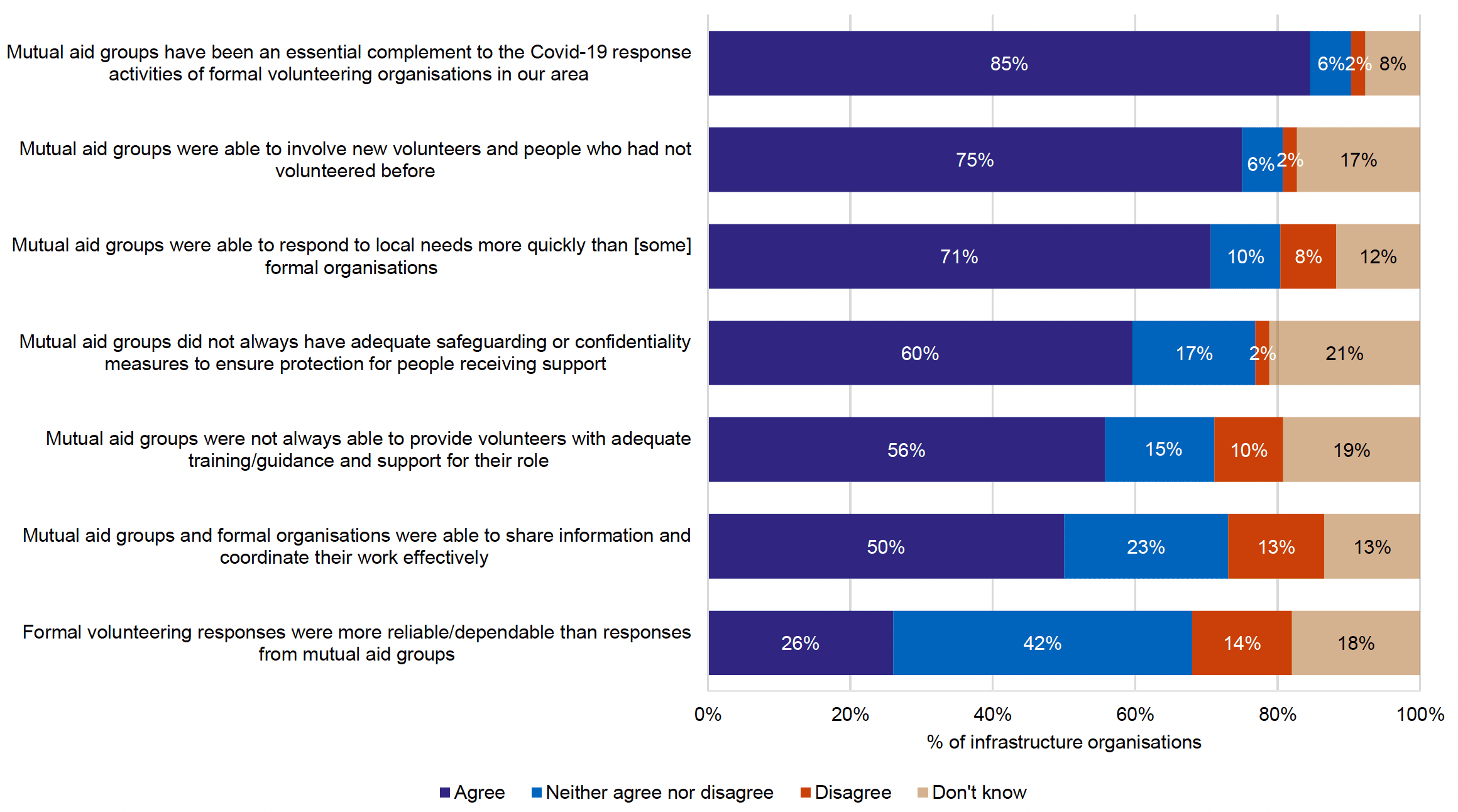
'I was horrified at the lack of safeguarding and thought that was put into their volunteering practices. No references, safeguarding etc., we tried to intervene to offer support and raised our concerns with these agencies but no further structure was put in place to protect the people they were helping.'
'Over the last year social media groups have morphed from spaces to ask for assistance to spaces for resource and information sharing, with the direct calls for assistance being signposted to established organisations.
Some mutual aid groups have been very reluctant to engage with formal structures, not wanting to be seen as a traditional charity and focusing on a very grassroots approach. This has only seen success in a limited number of groups, usually those that were led/administrated by one or two individuals, and bigger groups were more susceptible to drop-off in terms of support and poor management. The biggest issue we have encountered where mutual aid groups are run entirely through Facebook or other social media; there is limited accountability but also a very public platform where grievances can be aired and then escalated.'
Overall, the responses suggest that mutual aid groups were essential to the COVID response, and that some of them intend to continue to operate in some form beyond the pandemic. Infrastructure organisations are focusing on helping them to adapt to define their post-COVID role, and integrating them into local resilience arrangements and other coordination networks.
[Local Authority area] is a small local authority with very diverse communities however local people got together to support their community and these community response teams have become established organisations and are planning for the future and how they can support their own local area as restrictions are eased.
'The lockdown has increased awareness of issues in some areas e.g. one group reported that they never knew there were so many lonely and isolated people in their communities; some groups have discussed making themselves a permanent fixture in the area.'
4.2 Informal volunteering
Informal volunteering has been another major component of the community-level response to COVID-19, and one that has seldom been seen and recognised on this scale, at least in recent decades. This is even more difficult to quantify than mutual aid volunteering, because it is defined as individual volunteering not linked to any group or organisation. However, infrastructure organisation responses suggest that informal volunteering took place on a very large scale, and acknowledge the extremely important role that this has played in maintaining a degree of connectedness and community, through months of relative isolation for many people. As with mutual aid, respondents considered that the fact that many people were at home, and/or on furlough schemes, meant that they had more time available to support others in their communities.
As shown in Figure 4.5, 90% of the respondents agreed or strongly agreed that informal volunteering had helped to combat social isolation and loneliness, while 87% agreed or strongly agreed that informal volunteering had been an essential complement to formal volunteering. Eighty-five percent agreed or strongly agreed that it had strengthened community spirit and identity. According to one infrastructure organisation:
Both formal and informal volunteering approaches were needed, appropriate and very effective in ensuring people received vital help and support
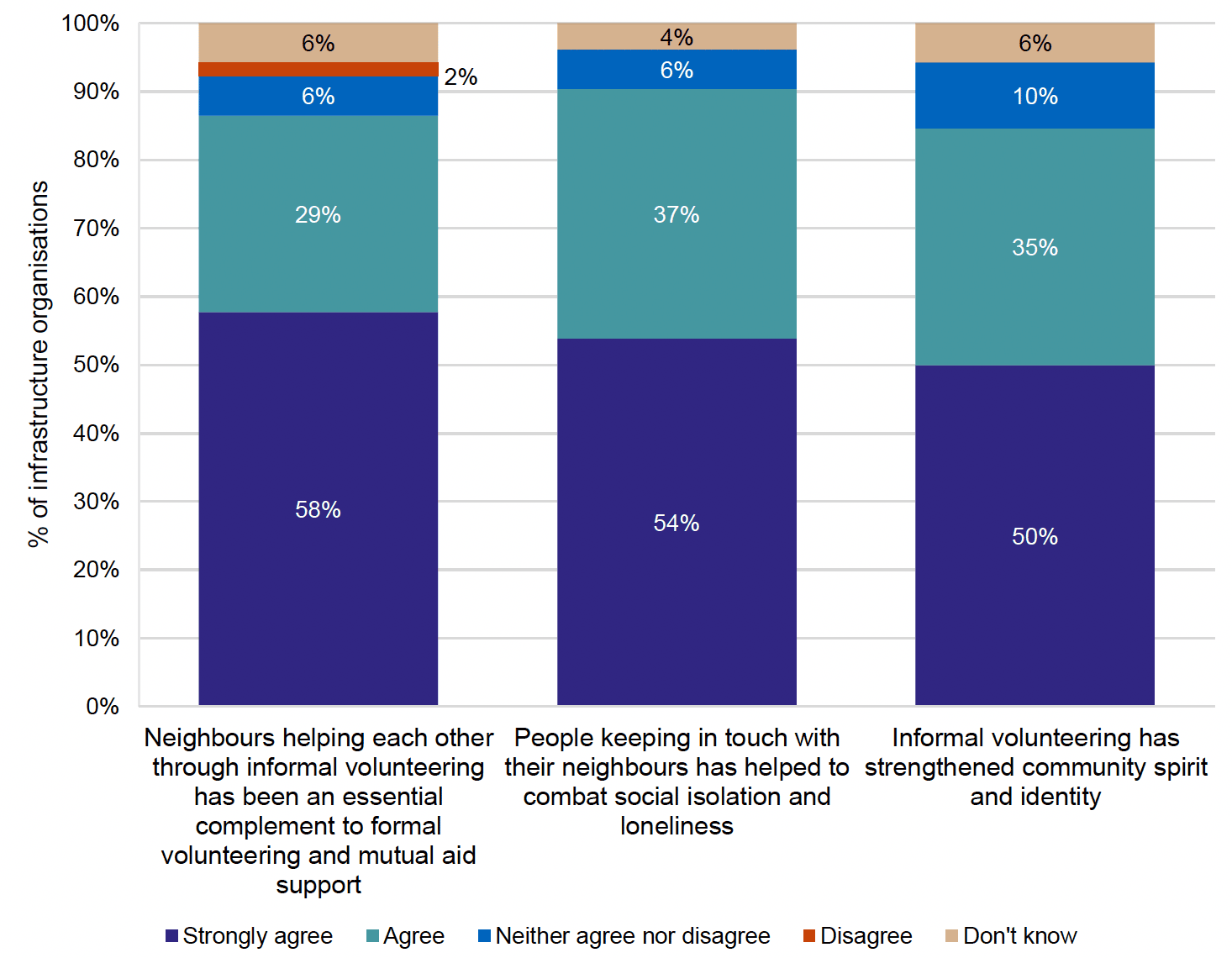
Some respondents noted how initial contact to provide practical support at the height of the first lockdown had led to longer term support relationships in some cases, as well as raising awareness of issues such as social isolation and loneliness within neighbourhoods.
'People have carried on helping their neighbours with e.g. prescription pick-up months after the initial lockdown. They have developed relationships with these people which would not have been possible prior to the pandemic. These relationships have led to better conversations which have led to new needs being established.'
The lack of data on informal volunteering makes it unclear how inclusive it was, or how broad its coverage was. One respondent struck a note of caution in this respect, suggesting that community-based volunteering responses had not reached all groups and areas equally:
'It is worth noting that in a recent survey done by the Minority Communities Hub, members of ethnic minority communities did not feel any more connected to their neighbours, in fact, it was felt by many that community cohesion was more fractured than ever before.'
4.3 How infrastructure organisations supported different types of volunteering
Infrastructure organisations – and the TSI network in particular – had a lead role in coordinating and supporting the volunteer response in local authority areas, typically undertaking tasks including signing up and assigning volunteers; establishing coordination structures; offering advisory support, guidance and information about all aspects of volunteering to VIOs; and funding advice and distribution (Figure 4.6).
'We quickly became a point of contact for local people to sign up and offer their help, by way of setting up online forms to receive such information very early on in the first lockdown. We then helped to match these volunteers to the available roles and opportunities.
A daily meeting of lead people within local voluntary organisations, and other partners, quickly became established to allow for ongoing oversight and problem-solving with regard to the volunteer response and other operational challenges.
Continued offer of support for VIOs in all aspects of working with volunteers. Our website became a hub of information on all things COVID, including support and funding options, for VIOs and communities.
We have administered funding on behalf of the Local Authority that included ongoing funding to groups providing food support and other essentials such as utilities and digital connectivity. We have also administered a COVID volunteer expenses fund open to all volunteers helping with the COVID response.'
Faced with a patchwork of different levels of voluntary response across their areas, infrastructure organisations described how they worked with partners to identify areas where there was less volunteer support emerging at the beginning of the pandemic, and to fill any gaps.
'All 42 communities in [Local Authority area] had identifiable arrangements for mutual aid and community support. Where possible these were self-organised by the community using existing structures, however in a small number of communities where there was no clear support structure in place or emerging, [Third Sector Interface] supported neighbouring community organisations to extend their reach, including setting up and managing a team of volunteer community shoppers to respond to requests from vulnerable/shielding residents.'
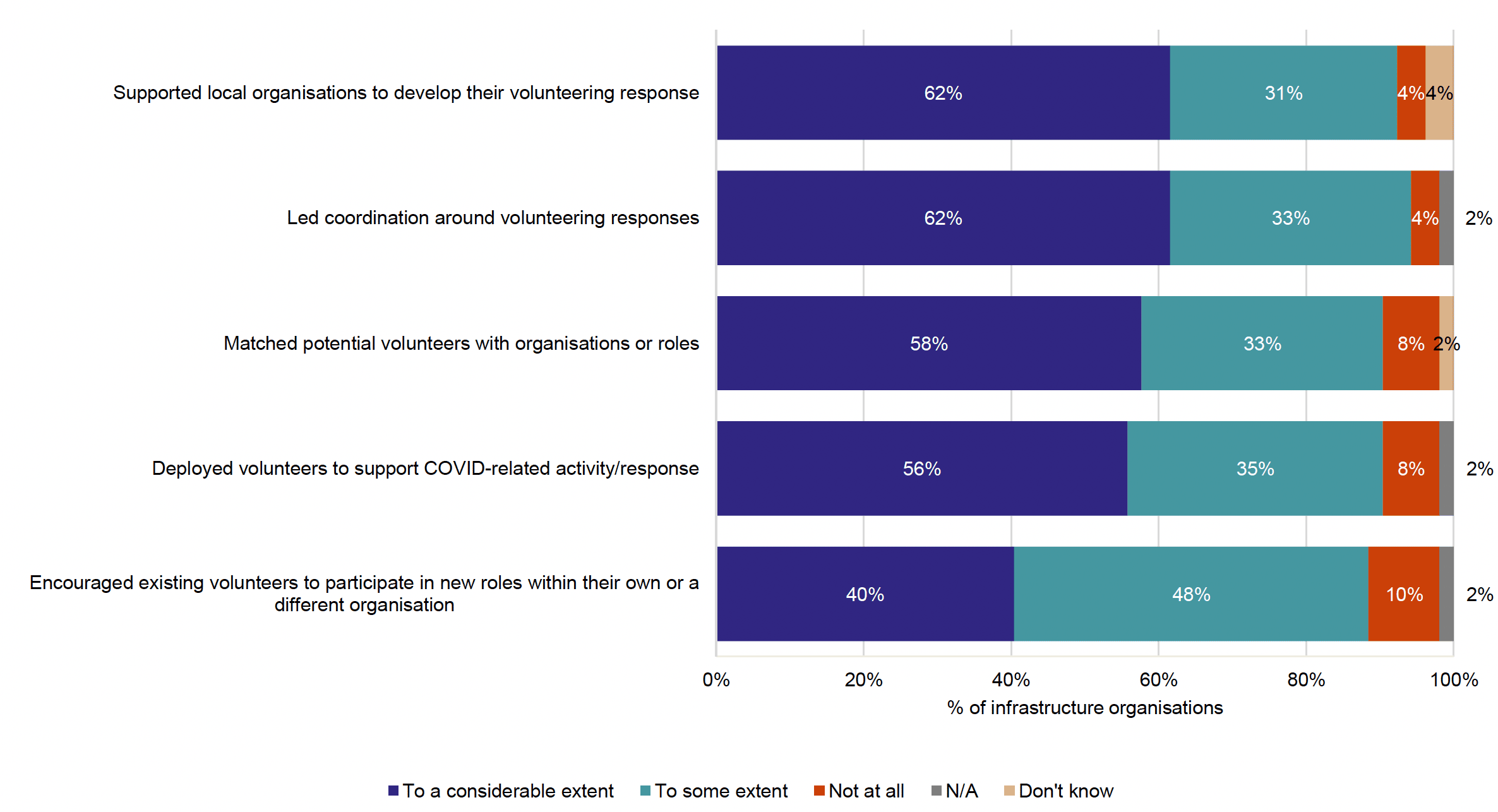
Providing support for new mutual aid/community support organisations became an important role for many infrastructure organisations, particularly TSIs and local authorities (Figure 4.7).
4.3.1 Support for mutual aid groups
At the start of the pandemic, many new community-based 'mutual aid' groups were created in order to harness the willingness of the public to get involved in the COVID-19 response. While some of these groups were linked to pre-existing community organisations, others were completely independent, created by concerned members of the public who wanted to do something.
It quickly became clear to infrastructure organisations that while their intentions were good, many of these groups had poor or non-existent organisational capacities; that they did not always have good safeguarding or COVID-safety procedures in place, and that they might benefit from support to help put more formal processes and procedures in place.
'Some activity led by volunteers – while stemming from a desire to help – saw organisations unintentionally working with little or no protective procedures in place and or in isolation from public sector and other community efforts. This was understandable given the emergency situation and largely volunteers responded quickly and worked with partner agencies as the situation progressed to improve and develop safe and coordinated working practices.'
The support that infrastructure organisations have provided to these groups has been wide-ranging (Figure 4.7), including:
- providing information on how to help mutual aid organisations deliver their services safely during COVID-19 (provided to a 'considerable' or 'some' extent by 83% of infrastructure organisations)
- providing lists of formal organisations that mutual aid groups could signpost users to (79%)
- providing advice on volunteering good practice, including volunteer management (77%)
- helping mutual aid groups to become compliant with legal requirements (75%)
- advising mutual aid groups on how to register themselves as formal organisations, if they wanted to do so (75%).
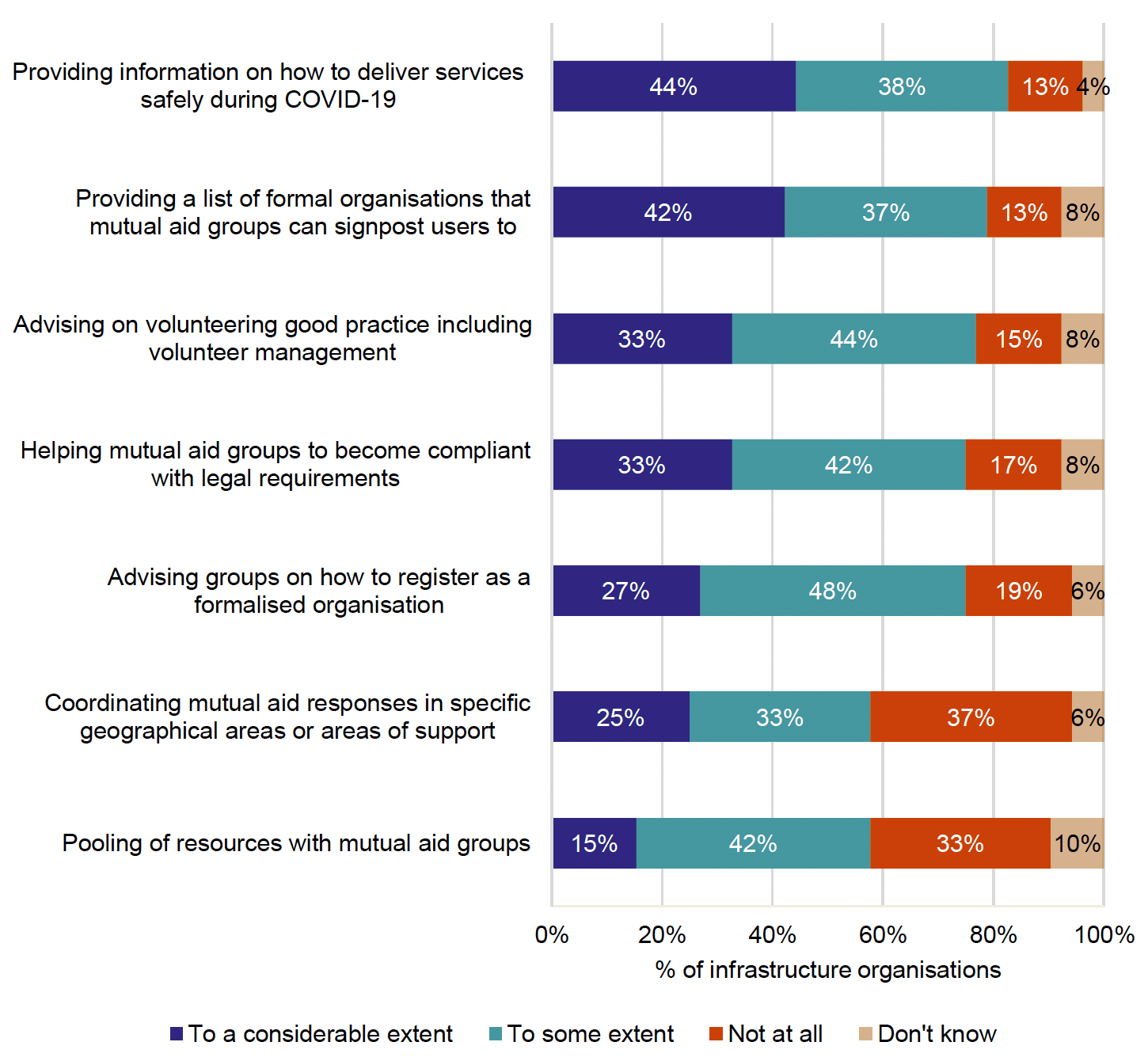
'Like many areas in Scotland there was significant numbers of mutual aid groups in [Local Authority area]. Some started as Facebook groups, but moved quickly to become constituted organisations, with the TSI's help. In our opinion it was important that this development work happened to support the groups to access funding and operate safely. Other groups stayed as Facebook groups, and have since disbanded or morphed into community information sites.'
'Our team compiled advice and training about safe food handling, shopping and delivering food to vulnerable people.'
'We have supported mutual aid groups with volunteer management support, COVID volunteering guidance, safer volunteering advice, and volunteer recruitment and support advice and TSI partners have supported with funding and governance.'
4.3.2 Support for informal volunteering
Sixty-nine percent of infrastructure organisation respondents indicated that they had supported informal volunteering in some way. The support that infrastructure organisations provided for informal volunteering focused primarily on creating advice and guidance on volunteering safely and good practice. Many respondents talked about using their websites and social media to promote this. Several mentioned having developed films or postcards targeted at informal volunteers. Infrastructure organisations also made efforts to link informal volunteering efforts with the work of local community/mutual aid groups.
'As part of making our website a hub of information, we created a 'Being a Good Neighbour' guide that we sent to everyone who signed up to offer their help, and was available to all on our website. This provided guidance around safely helping your neighbours, including COVID measures and boundaries.'
4.4 Volunteering coverage across different areas
We asked infrastructure organisations whether they felt that the volunteering response had varied across different geographical areas, or according to levels of deprivation.
4.4.1 The volunteering response in rural and urban areas
The majority of respondents listed rurality as an important determining factor for volunteering in their area. Many highlighted positive responses in rural areas, suggesting that smaller communities, such as villages, had been effective in organising themselves quickly to ensure support within their communities. Respondents suggested that this was partly due to the role of local knowledge and partly to a prior sense of belonging or community, and in some cases pre-existing support structures. Several respondents indicated that emergent voluntary groups in rural areas had been able to use digital platforms for communication and organisation effectively.
Challenges in rural areas arose in relation to the lack of public transport to support volunteering efforts – so that volunteers were generally reliant on their own transport – and ensuring that the response was able to reach people in remote or isolated areas, outside of villages. There were specific challenges for island communities where ferry traffic was reduced significantly due to pandemic regulations, limiting access to shops on the mainland and increasing reliance on a small number of suppliers.
'[Local Authority area] has many more rural areas and local people have to be commended for how they stepped up and organised themselves to look after their own areas. Local area knowledge helped and social media and online communications played a big part in helping to connect people, especially during the more difficult winter weather that hit the area.'
'We saw that in small rural communities people had knowledge about individuals and families and were able to offer the right support to different households quickly and without judgement.'
'New groups and networks emerged in rural communities, and digital platforms were increasingly used to communicate and organise activities. [Rural area] in particular saw an increase in groups operating relatively independently from the council and providing food to local communities.'
Some respondents suggested that community-based volunteering responses emerged more quickly in rural than in urban areas. They considered that the urban volunteering responses in their areas had required greater external support and organisation by formal partners.
'Mutual aid responses were much more prevalent in rural areas where there is a greater sense of community. In the more urban areas responses had to be more centralised or supported – it was more difficult to associate the volunteers with a particular area.'
4.4.2 Volunteering response in areas of higher deprivation
We asked infrastructure organisations to tell us how they thought the numbers of volunteers supporting areas of higher deprivation had changed during the first and second lockdowns, compared with before the pandemic (Figures 4.8 and 4.9). For both lockdowns, the majority of infrastructure organisations felt that the numbers of volunteers supporting areas of higher deprivation had increased compared with before the pandemic. This was particularly true for informal and mutual aid volunteering, with a significant proportion of infrastructure organisations indicating that formal volunteering numbers had reduced in both lockdowns. Overall, the picture of change in volunteering numbers for areas of deprivation appeared to be in line with the national picture.
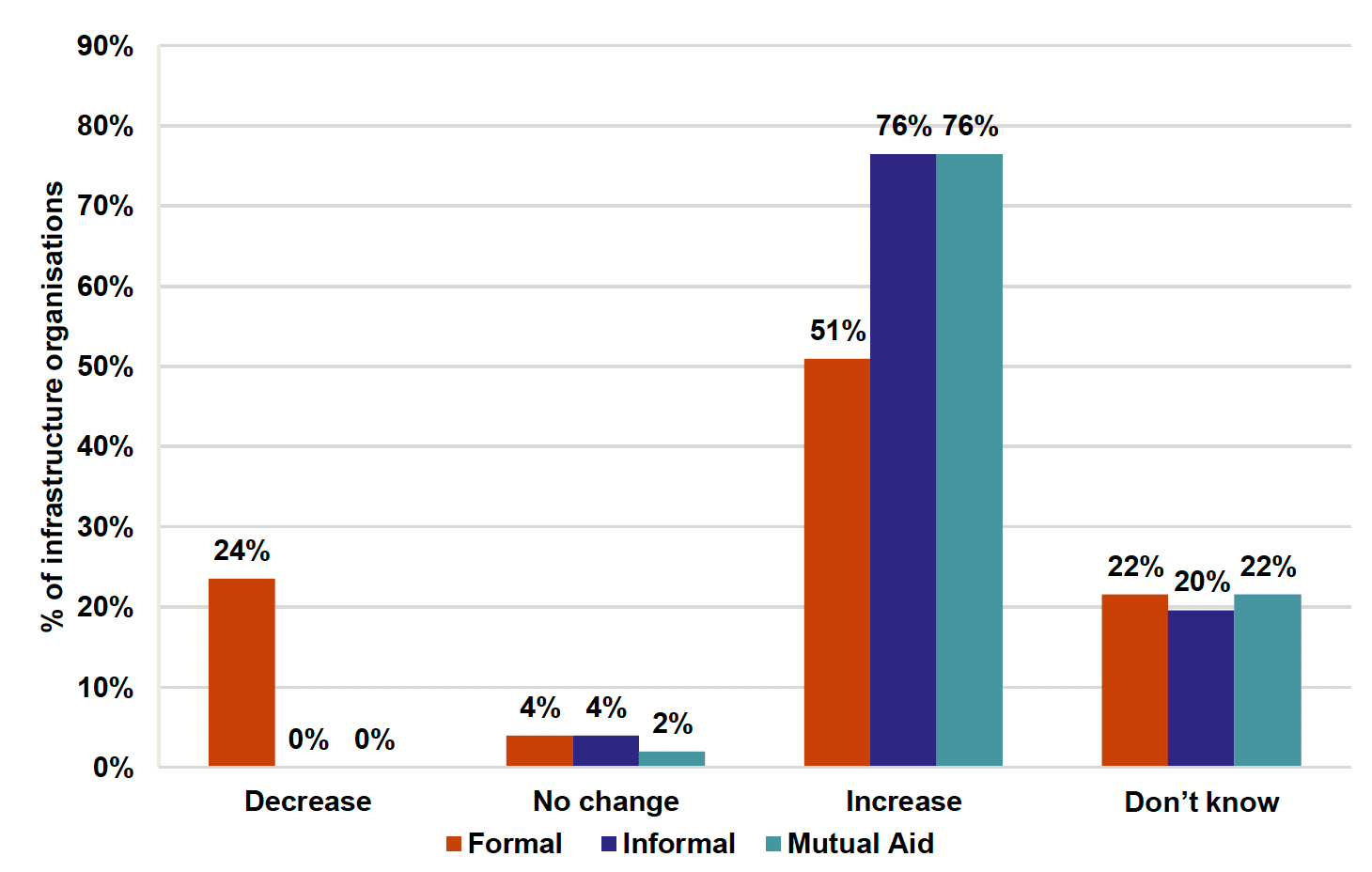
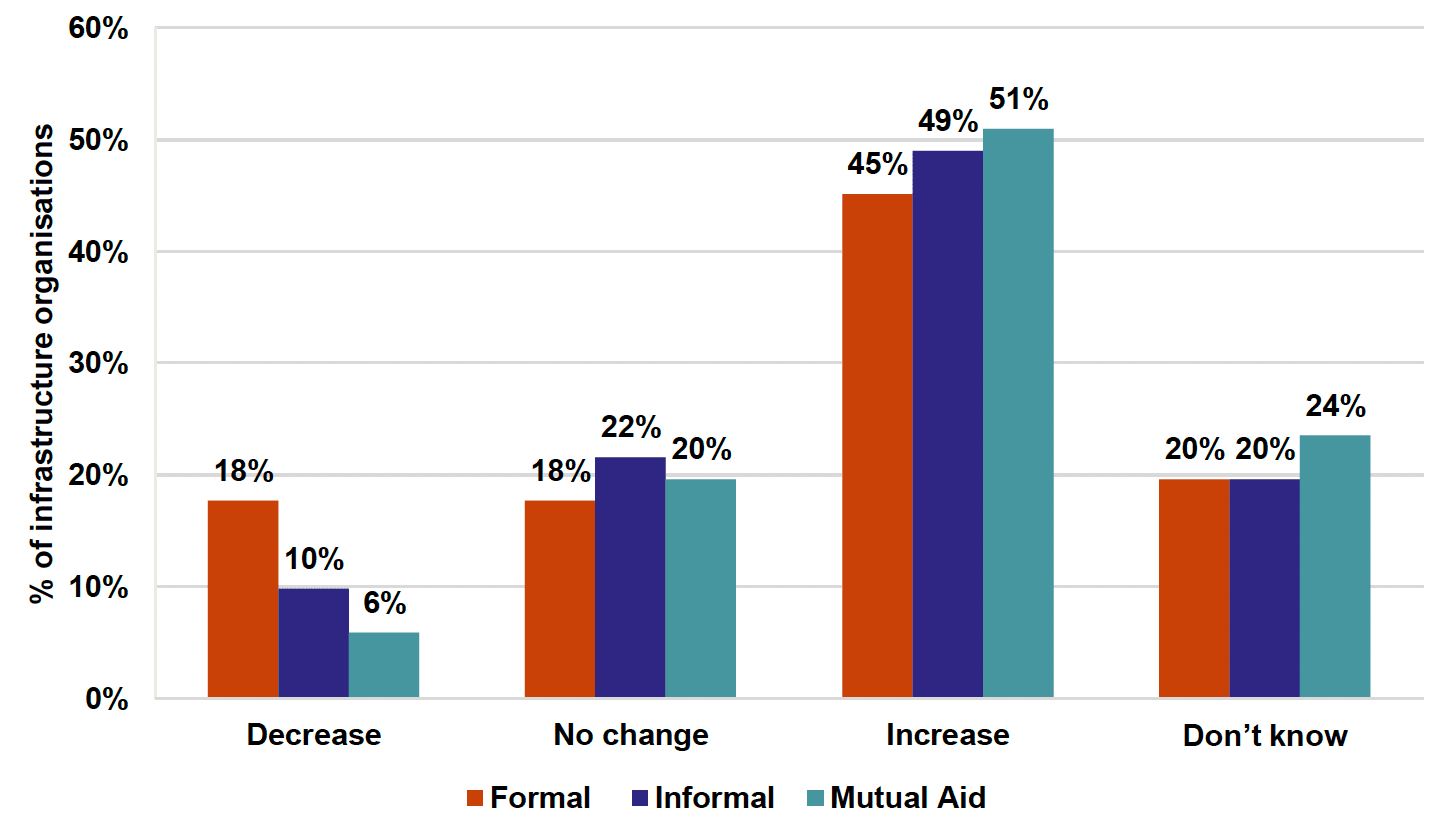
Infrastructure organisations gave a range of qualitative perspectives on volunteering in more deprived areas. Some considered that the response had been particularly strong in areas of higher deprivation. Others noted that the response in areas of higher deprivation required more statutory support.
'Each area in [Local Authority area] has it "own way" of "doing" or "supporting" their community/town. More affluent areas were able to quickly pull together databases, organise deliveries etc. and co-ordinate effectively whereas the areas higher on the SIMD index struggled with the digital and co-ordination … The smaller villages "rallied" really well setting up food supplies/meals etc.'
'If anything, I think those that are often thought of as hard to reach were more willing to engage [as volunteers] during the pandemic. Perhaps because services were local, and led by others in their community that they know/trust.'
'Our areas of "deprivation" provided some of the strongest on the ground responses.'
'I don't think there were any areas [in Local Authority area] where local people weren't mobilised to support their local area whether urban or rural, deprived or affluent. It was a privilege to watch local people come together and to be able to support them in their efforts to care for the vulnerable in their community.'
Contact
Email: socialresearch@gov.scot
There is a problem
Thanks for your feedback